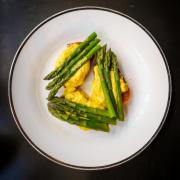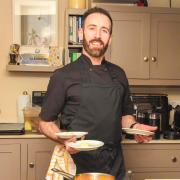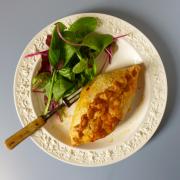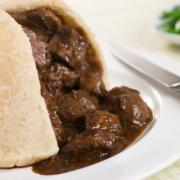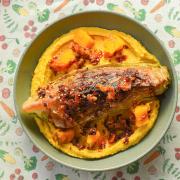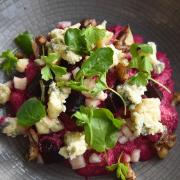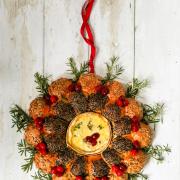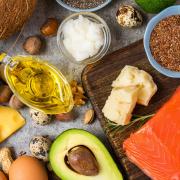October 21 is Apple Day. Get tips on growing apples from veteran Suffolk grower Dan Neuteboom and make Linda Duffin’s delicious apple tart recipe

October is the 30th anniversary of the annual Apple Day but Dan Neuteboom has spent double that time growing apples and is a real champion for English fruit.
From the deep veranda of his home in the heart of the Braiseworth orchards near Eye, Dan gives me his take on what reviving rare or heritage varieties is all about. He shares the story of a friend who was growing what she described as an “interesting” variety of pear. And he told her: “You may say, after three years, yes it is interesting but it doesn’t have any fruit!”
Since retiring from commercial growing, Dan has been trying out varieties of apples and pears with a focus on the health and welfare of the older trees which he says can often be undervalued. Having formerly introduced such successful varieties as Suffolk Pink and Winter Wonder, he knows what to look for in a decent apple
The start of Dan’s horticultural journey from the early age of eight or nine was a hard one. Growing up in the Dutch village of Strijen in the island of Hoeksche Waard, he recalls the German invasion when they smashed the dykes so that salt water poured into food-growing areas.

“My father was a GP and had lots of patients on the point of starvation,” he says. “During the war, we literally survived on whatever the garden produced. When I came home from school, my mother told me to go out and collect apples from our three trees in the garden. She would slice them and hang them to dry in the airing cupboard.”
Even the family pig ate the apples, says Dan. It was at this young age that he learned the value of organic matter for growing fruit. His mother, a farmer’s daughter, instructed him to collect chicken manure to put under the apple trees. And many of his relatives were growers with glasshouses, “so I really felt that growing things was the real life. That’s how I started.”
Emerging from university with a degree in specialist fruit growing, he succeeded in finding a place in the UK at Studley Horticultural & Agricultural College.
“What a wonderful surprise it was,” an amused Dan recalls. “It turned out to be a girls’ college and (his wife) Henrietta was one of the students, so I married her and here we are living happily together, both really keen horticulturalists, for the last half century.”

Henrietta has created an idyllic garden surrounding the house as well as the wildflower meadow that’s so crucial to the orchard fruit with its natural pollinators and predators keeping chemical control of aphids to a minimum.
Read: the former Felixstowe College girl who became Britain’s first woman football reporter

The couple sold their commercial fruit-growing company, Hemingstone Fruit Farms, in 2002. The Braiseworth operation is now owned jointly by daughter Kathy and her partner, Jeremy, who are replanting and renewing the orchards as well as allowing wild flowers to flourish.
As we sip the delicious apple juice from ‘Winter Wonder’, the variety introduced by Dan in the late 1970s, he draws attention to the sturdy oak trees nearby.
“Every morning at breakfast out here we look at the oaks and say, there’s 300 years of growth there! That tells you something about the soil, the most beautiful loam over clay. And for growing healthy fruit trees, you have to keep the soil alive with fungi, nematodes, insects everything. When the soil is open with oxygen the roots can get right down.”
In retirement, Dan has been fascinated by what older trees can achieve in producing good quality fruit providing they receive the proper care. He takes special pride in showing me a row of fruit trees of different varieties planted 55 years ago.

“Provided the size of such trees is gradually reduced, the soil well drained and the fruit thinned out at a very early stage, it is remarkable how well they respond.” He even likens this to his own ageing process – he’s in his eighties – admitting that “working with older trees on a regular basis generates a feeling of mutual respect and loyalty”. The knarled trunks of older trees are especially valued in a garden setting, he says.
He reckons it takes a lifetime to find out the characteristics of trees.
“We are all different and with apple varieties it’s exactly the same. When I go summer pruning, I walk past the trees first to see what they are telling me in, for example, the way they hold the shoots, the amount of new growth or the bearing of the fruit.” Decades of growing experience and sampling numerous varieties has given Dan the edge when it comes to selecting trees and choosing apples out of some 6,000 varieties.
Local Suffolk apples such as Lady Henniker, Sturmer Pippin and St Edmund’s Pippin may be historically interesting but Dan is underwhelmed.
“If you plant an apple tree, it’s important to know if you will get good tasting fruit and regular cropping,” he says.
For gardeners with limited space, his choice is the self-fertile Red Pippin which was introduced as the Spanish-sounding Fiesta in 1987 at East Malling Research Station.
“It’s so suitable for the English climate and never lets you down. It is crisp, good to eat and has a certain keeping quality,” says Dan. He also recommends Greensleeves which ripens at the end of August, and Howgate Wonder, a long-keeping dual purpose apple.
“James Grieve is another I would plant because it always crops. In mid-August it’s completely green and slightly acidic – an early cooker before the Bramleys come - but if you wait three weeks, it’s a sweet apple.”
If space is not an issue, Dan’s number one choice is the intensely aromatic dessert apple Suntan but it takes at least two or three years to crop and requires two pollinators, he explains, so has not been readily taken up by growers.
Some of the best apples have been discovered by chance. Suffolk Pink came about in the 1980s when Dan ordered a batch of Greensleeves from the late Jack Matthews of Thurston who introduced the well-known Discovery variety, also a chance seedling.
“I noticed one of the trees looked a bit odd,” says Dan. “But I planted it and it produced the most fantastic apple, so crisp and tasty.” Now Waitrose is the sole supplier of Suffolk Pink and 20 per cent of the current Braiseworth orchards acreage is devoted to it. It was a similar case with the crisp and aromatic Winter Wonder in the late 1970s. In a row of Suntan trees Dan had grown, one was different from the rest. He identified it as a Suntan sport and began to propagate it for supermarkets and farmers’ markets. He is a regular at farmers’ markets in Beccles and Rickinghall.
“When we started in 1960, there were over 300 fruit growers in Suffolk and now there are barely 30 left,” says Dan. But he believes that, with replanting and renewal, the Braiseworth orchards have a bright future.
In the meantime, he is more than happy to continue his research on fruit growing and sharing it with others on a remarkable website that includes his own video tutorials, pictures and compelling stories about apple growers in Suffolk.
“I did this for the benefit of every gardener enabling them to grow their own fruit trees with success and satisfaction.”
Find out more at realenglishfruit.co.uk
Dan’s 7 recommended varieties
Red Pippin – self-fertile, good for limited space
Greensleeves – ripens at the end of August
Howgate Wonder – long-keeping, dual purpose
James Grieve – reliable cropping
Suntan – aromatic dessert apple, requires space and two pollinators
Suffolk Pink – crisp and tasty
Winter Wonder – crisp and aromatic
RECIPE: SUFFOLK APPLE TART
A simple and delicious recipe from Suffolk food writer and blogger Linda Duffin (aka Mrs Portly) – just right for autumn
Ingredients
1 kg cooking apples
2-4 eating apples, depending on size
The juice of 1/2 lemon
About 3 tbsp granulated sugar
1 sheet ready-rolled shortcrust pastry
1 tbsp butter, diced
Apricot jam, to glaze
Method
Peel, core and slice the cooking apples. Put them in a pan with about 2 tbsp sugar and a splash of water. Cook gently, stirring occasionally, until they have broken down into a purée. Taste and add more sugar, to taste, and allow to cool.
Lightly grease a six-portion flan tin with a removable base. (I used a rectangular tin measuring 35 x 12 cm.) Line it with the pastry, leaving the edges high to allow for shrinkage, and chill in the fridge for 20 minutes. Heat the oven to 220C/425F/Gas Mark 7. Peel, core and thinly slice the eating apples and put them in a bowl with the lemon juice to stop them going brown.
Fill the tart case with the apple purée and arrange the slices in overlapping rows on top. Trim the edges of the pastry, sprinkle the top with more sugar and dot with butter, then bake in the oven for 10 minutes. Now turn the oven down to 200C/400F/Gas Mark 6 and bake for a further 15-20 minutes or until the pastry is light brown and the apples have caramelised.
Remove from the oven and allow to cool slightly before removing the tart from the tin. Warm the apricot jam with a tablespoon of water, sieve, and brush over the tart.
Serve warm or cold, with cream, crème fraîche or vanilla ice cream.
Find more of Linda’s food ideas and recipes at mrsportlyskitchen.com




